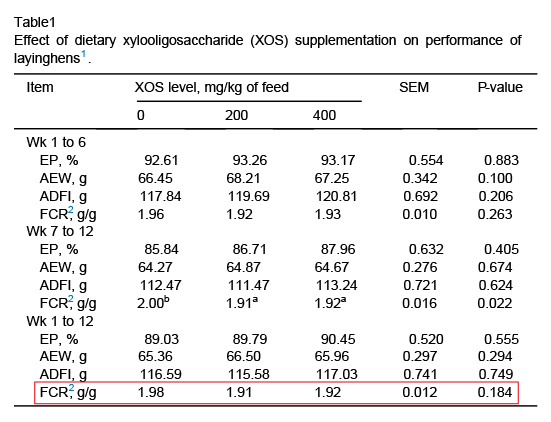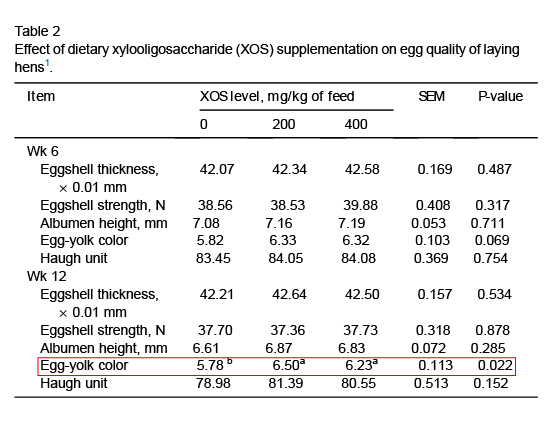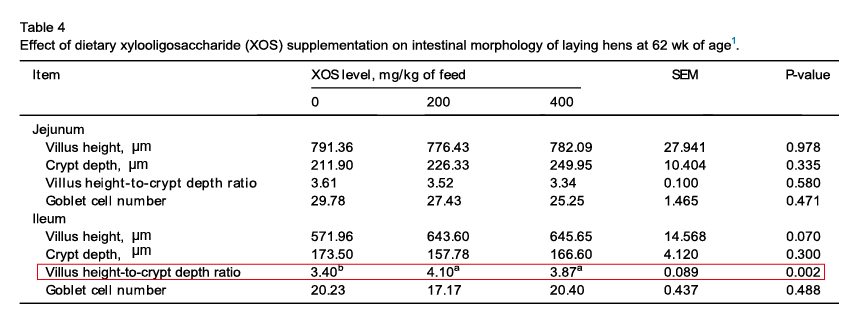
动物的肠道微生物群在自身机体的营养吸收、免疫系统发育以及减少病原菌感染等方面发挥着重要作用,机体通过肠道微生物调节微生态,从而达到促进生长、维持健康的结果[1]。大量研究表明,养殖鸡的肠道微生态与鸡的整体性能和肠道健康有很大的关联性[2-7],这会影响到最终的养殖效益。
Jianmin 等人[12]选取288只50周龄的海兰褐蛋鸡,分为3个处理组(每组8个重复,每个重复12只鸡),分别在饲粮中添加0、200、400 mg/kg 的低聚木糖(纯度95%),试验为期12周。试验结果表明: Table1 和 Table2 所示,与对照组相比,添加200和400 mg/kg 低聚木糖饲粮的蛋鸡料蛋比(FCR)显著降低(P <0.05);在第12周时, 低聚木糖添加组的蛋黄颜色值增加(P <0.05)。 |
 |  |
| (2)消化性能 Table3 所示,与对照组相比, 低聚木糖添加组蛋鸡总能(GE)的表观总肠道消化率系数(ATTD)显著增加(P<0.05);饲粮中添加200和400 mg/kg 低聚木糖分别使蛋鸡氮(N)的表观总肠道消化率系数(ATTD)提高了24.0%和23.7% (P<0.05)。 | (3)肠道结构形态 Table4所示,与对照组相比,饲粮中添加200和400 mg/kg 低聚木糖蛋鸡回肠绒毛高度与隐窝深度之比(VH/CD)更高(P<0.05),改善了蛋鸡的肠道结构,有利于蛋鸡的总消化性能和肠道免疫屏障功能。 | |
 |  |
(4)肠道微生态 低聚木糖不会被单胃动物的消化酶分解,可直接进入鸡的肠道,促进有益菌的增殖,抑制有害菌的增长,产生抗菌物质和短链脂肪酸,形成微生物屏障,激活动物肠道微生态,改善动物的肠道功能,通过调节营养物质消化率和回肠形态来改善料蛋比,从而促进营养物质的吸收利用、调节动物机体免疫系统,提高动物性能,提高养殖效益。 参考文献: [1] Pandit RJ, Hinsu AT, Patel NV, Koringa PG, Jakhesara SJ, Thakkar JR, et al. Microbial diversity and community composition of caecal microbiota in commercial and indigenous indian chickens determined using 16s rDNA amplicon sequencing. Microbiome 2018;6:115e21. [2]Crisol-Martínez E, Stanley D, Geier MS, Hughes RJ, Moore RJ. Understanding the mechanisms of zinc bacitracin and avilamycin on animal production: linking gut microbiota and growth performance in chickens. Appl Microbiol Biotechnol 2017;101:4547e59. [3]Peng Q, Zeng XF, Zhu JL, Wang S, Liu XT, Hou CL, et al. Effects of dietary Lactobacillus plantarum B1 on growth performance, intestinal microbiota, and short chain fatty acid profiles in broiler chickens. Poultry Sci 2016;95:893e900 [4]Salaheen S, Kim SW, Haley BJ, Van Kessel JA, Biswas D. Alternative growth promoters modulate broiler gut microbiome and enhance body weight gain. Front Microbiol 2017;8:2088 [5]Wu SR, Li TH, Niu HF, Zhu YF, Liu YL, Duan YL, et al. Effects of glucose oxidase on growth performance, gut function, and cecal microbiota of broiler chickens. Poultry Sci 2019;98:828e41 [6]Zhu N, Wang J, Yu L, Zhang Q, Chen K, Liu B. Modulation of growth performance and intestinal microbiota in chickens fed plant extracts or virginiamycin. Front Microbiol 2019;10:1333. [7]Zou X, Ji J, Qu HX, Wang J, Shu DM, Wang Y, et al. Effects of sodium butyrate on intestinal health and gut microbiota composition during intestinal inflammation progression in broilers. Poultry Sci 2019;98:4449e56. [8]Craig AD, Khattak F, Hastie P, Bedford MR, Olukosi OA. Xylanase and xylooligosaccharide prebiotic improve the growth performance and concentration of potentially prebiotic oligosaccharides in the ileum of broiler chickens. Br Poultry Sci 2020;61:70e8. [9]Ribeiro T, Cardoso V, Ferreira LMA, Lordelo MMS, Coelho E, Moreira ASP, et al. Xylooligosaccharides display a prebiotic activity when used to supplement wheat or corn-based diets for broilers. Poultry Sci 2018;97:4330e41. [10]Lin Y, Li WL, Huo QQ, Du CH, Wang ZX, Yi BD, et al. Effects of xylo-oligosaccharide and flavomycin on the immune function of broiler chickens. PeerJ 2018;6: e4435. [11]Pourabedin M, Chen QL, Yang MM, Zhao X. Mannan- and xylo-oligosaccharides modulate cecal microbiota and expression of inflammatory related cytokines and reduce cecal Salmonella enteritidis colonization in young chickens. FEMS Microbiol Ecol 2017;93:fiw226. [12]Jianmin Zhou;Shugeng Wu;Guanghai Qi;Yu Fu;Weiwei Wang;Haijun Zhang. Dietary supplemental xylooligosaccharide modulates nutrient digestibility, intestinal morphology, and gut microbiota in laying hens[J].Animal Nutrition,2021,Vol.7(1): 152-162. |